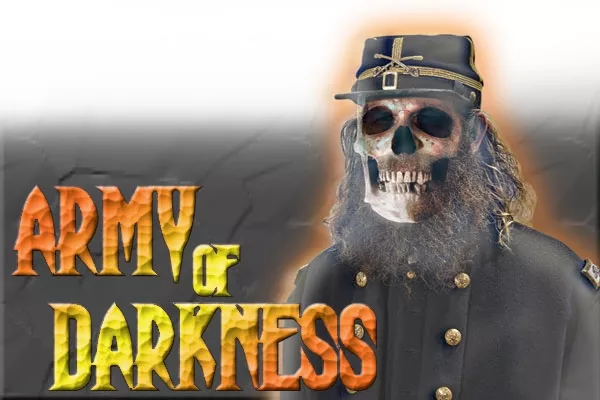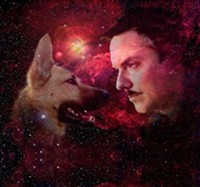Army of Darkness
Hunting the gamblin', murderin' soldier ghosts who haunt Fort Douglas
By Colin Wolf @wolfcolinThis town sure as hell isn’t what it used to be.
For starters, the moral capital of the West used to be filled with men who would shoot one another over card games and floozies—at least, that’s how history remembers it, and that’s why a crew of local ghost hunters and I were hanging around the Fort Douglas Military Museum late on a Wednesday night.
We were looking for ghosts. Correction: old-timey, prostitutin’, gamblin’, whiskey-drinkin’, murderous military ghosts!
Now part of the University of Utah campus, Fort Douglas was established in 1862 for two primary reasons: Washington needed to keep the mail route open to the West and, more importantly, the bureaucrats wanted to keep a close eye on those multiple-wives-havin’ Mormons.
What’s left of the fort’s barracks are two partially remodeled structures, now used as the fort’s main museum buildings and called simply Building 31 and Building 32. In the interest of increasing our chances of paranormal findings, ghost hunters Helmey Kramer, Jennifer Doane and Jason Magers and I concentrated our efforts on these two locations.
The following story is based on actual events.
Museum curator Beau Burgess gave us a brief tour of the complex. Besides the many military-related pieces, the museum is filled with all types of bizarre little knick-knacks: a World War I horse gas mask, the boots Saddam Hussein was wearing when he was captured and—my personal favorite—a weird little bronze Hitler head that Burgess claims might have been the same one that opened the secret fireplace door in Indian Jones & the Last Crusade.
Eventually, Burgess led us into a small storage room below Building 32, a spot referred to by Fort Douglas museum staff as the card room.
“I’m not particularly sure what this space was originally used for, but it’s rumored that people would gamble, drink and smoke cigars in here, and it’s pretty much the same [now]—minus some wiring and infrastructure updates,” Burgess said.
The card room was the main reason we were at Fort Douglas. The rest of the building was remodeled, but this particular space remained mostly untouched, besides new lighting that let us see the crumbling brick walls and the old wooden beams that lined the low-hanging ceiling. It also smelled like a grandpa’s basement office.
I know this doesn’t sound very scary, but apparently, this room has the most reported cases of paranormal activity.
“Some people have told stories of smelling cigar smoke in here, or seeing smoke coming out of the doorway. I haven’t seen anything, personally,” Burgess said.
While standing in the card room, we hatched a plan for the evening and figured that the best way to cover as much ground as possible was to spend half the time in Building 31 and half in 32, while leaving recording equipment in whatever building we weren’t in.
“There are no rules with this stuff; anyone who says otherwise has watched too many TV shows,” said Helmey Kramer, a cast member of Biography’s weekend ghost show Haunted Encounters. Kramer is sort of the unofficial leader of this ghost group. He’s a salt & pepper-haired über-man—think George Clooney in cargo pants, driving a Jeep Rubicon while discussing the pros and cons of ghost-centric condenser mics.
“Contrary to popular belief, you get better stuff when the lights are on; it’s more visual. I’m using an HD cam and I’m running motion-detection technology, so I’m just gonna set it up here and if anything moves, or there’s a deviation, it’ll pick it up,” Kramer said while rubbing his goatee.
As for the other two ghost hunters, there’s Jason Magers—a commercial pilot built like a linebacker, who seems to be doing this for the personal thrill of being spooked by scary ghosts—and Jennifer Doane, an insurance-appeals analyst by day and a ghost- hunting history buff on the weekends. Her phone is filled with PDFs of newspaper clippings about old murders and suicides.
“Gambling was a really bad problem at Fort Douglas—so bad that they were discussing getting rid of the fort because the soldiers were causing so many problems for the locals,” Doane said. “Quite a few guys were killed over card games here.”
It’s Doane’s history-first approach to ghost hunting that initially piqued my interest to do this story. The way these three see it, the more they know about a specific location and the people who occupied that space, the better are their odds of picking up something paranormal.
“We don’t do, like, the typical ‘Who is here with us?’ method; we try to have it be more organic and have conversations that would involve the people that might have been here,” Doane said.
“Look, we operate under the basic assumption that ghosts are people that were once alive,” Kramer said. “So, our conversations will revolve around the kinds of things that mattered to them. I mean, if you’re walking by and you hear someone talk about something that interests you, you’re more likely to say your two cents. We get much better results doing that.”
Though they work together often, Kramer, Doane and Magers actively avoid the term “team.” Doane used to run one of the many local ghost-investigation groups; Kramer and Magers were both on her squad.
“There’s more drama in the paranormal community than you can imagine—people being jealous, all kinds of crazy stuff,” Doane said.
“Yeah, we’re not really a team,” Kramer interjected as he finished setting up the motion detector, “because teams are tools with matching T-shirts and all that. We’re just explorers that like to go out and do this stuff.”
With everything set up in the card room, we moved back to Building 31 to hang out in the naval room and, hopefully, have a real-time conversation with a ghost. This particular space is filled with mostly World War II Pacific Theater artifacts and photos, and is themed so that you feel like you’re inside a ship.
“So, what do you guys think we’re gonna find tonight?” I asked.
“I think it’s definitely going to be a soldier … I think our odds are good to come across a ghost from the early 1900s; prior to 1915, there’s been a ton of suicides and murders here. I can’t say if they were in this building, but the odds are good,” Doane said.
She sat on the floor, holding a video camera trained on Kramer, who positioned himself by the door, holding a microphone and wearing a headset. Magers and I sat in opposite corners of the room. The idea was to have a discussion about the corruption and death at Fort Douglas in the hopes that it would invoke some ghostly conversation.
Doane continued scrolling through her phone. “So, Colonel Clem. He tried to bribe the secretary of war with a box of cigars and a hundred dollars. It says here he got pissed when they found out. They didn’t prosecute him, though, and they sent the money and the cigars to the war department, where they sat unclaimed.”
“Yeah, ‘unclaimed,’ ” remarked Magers.
“I wonder if any of the folks here know Colonel Clem? Or had any personal dealings with him?” Kramer asked no one in particular, then paused. “Shhh, did someone just speak?” he asked.
Everyone looked blankly at one another.
“Dude, I heard something,” Kramer said. He continued to press the subject of Clem. “I have a problem with people who are not good people. I think I would have struggled with this Colonel Clem guy.”
We sat in silence, wondering if Kramer would hear anything on the headset. Nothing.
“There was also Albert Hackett. He was shot and killed by another officer, a teamster named Silas Smith,” Doane said, staring at her phone.
“All right, let’s go quiet after this,” ordered Kramer. “I wonder who else was shot here?”
Silence.
“Maybe your research was wrong, Jen. Maybe no one was shot here,” Kramer said, standing in a power stance.
“My research isn’t wrong,” Doane responded. “There was a guy who was shot and killed by his wife in 1897, and another guy named Joe Lunder, who was also shot and killed here.”
“I wonder if Joe is still hangin’ out?” Kramer said.
Silence.
“Someone just make a sound?” Kramer asked. “I heard a female moan.”
Coincidently, the microphone was pointed directly at me, a guy who had previously eaten an entire enchilada-style beef burrito.
“I … honestly ... ate a whole bunch of Cafe Rio before coming here,” I confessed. “You’re probably picking up all sorts of horrible things from here,” I said, pointing to my stomach.
“Yeah, that’s awkward,” Doane said with a laugh.
Just then, we heard a loud boom from the other room.
Kramer’s left eyebrow took it up a notch. “What was that?!” he yelled.
We headed into the other room to discover Magers’ GoPro camera, which he’d suctioned to a display case, had fallen on the floor.
Everyone stood around the camera as if it were a crime scene. Magers remounted it while Kramer explained that ghosts will often mess with recording equipment. “You never know, it would be cool to go back and check to see if anything came into contact with it,” he said. “I’ve seen video of full arms smacking cameras.”
We walked back to the naval room and spent the next half-hour discussing the space-time continuum, why we don’t see cavemen ghosts, if cat ghosts exist and whether The Sixth Sense was a shitty movie.
More by Colin Wolf
-
Catching Up With DJ Matty Mo
2014's DJ of the Year is keeping the good kind of busy
- Jan 7, 2015
-
Best Local Rap of 2014
Utah-released hip-hop you shouldn't sleep on
- Dec 31, 2014
-
There's a Michael Jackson tribute band in Park City tonight
- Dec 29, 2014
- More »
Latest in Cover Story
Readers also liked…
-
Forget the family pedigree—Robert F. Kennedy Jr should not be the next president of the United States
Trojan Horse
- Jun 21, 2023
-
Women decry harassment and toxic culture at St. George auto dealership
Men at Work
- Oct 11, 2023








